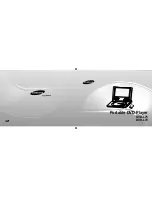
38
Technical description
Digital filters / Oversampling
The audio data on CDs is stored at a sampling rate of 44.1
- i. e. for each second of music 44.100 sampled values are
available for each channel. In the
CD 1260 R
the audio
data read from the CD is „multiplied“ to a higher sampling
rate (352,8 kHz) before it is converted back into analogue
music signals. This process delivers a very much better,
more finely graduated signal to the converter, which can
then be converted with correspondingly higher precision.
The raised sampling rate is a calculating process for which
there are many different mathematical methods. In almost
all digital audio devices which exploit the advantages of
increased digital sampling rate a process known as a FIR
filter is employed for this purpose. At
we have been
carrying out research for more than ten years, aimed at
improving the oversampling process, because the
standard FIR method has one drawback to set against its
indisputable advantages: it adds small pre- and post-
echoes to the music signals. At
we have developed
mathematical processes (known as Bezier polynomial
interpolators) which do not share this disadvantage. For
this reason they should sound better and more natural
than the usual standard process. Since the calculating
procedure employed by us is considerably more complex
than the standard method, the
CD 1260 R
features a high-
performance digital signal processor (DSP) which carries
out the over-sampling process with immense precision
(56 bit) using special algorithms developed by
.
The freely programmable DSP which we use is capable of
carrying out the oversampling process using any method
of calculation. For this reason we have implemented a
slightly modified Bezier processe (filters 3) in the
CD 1260 R
in addition to the pure Bezier process (filter 4),
together with two variants of the standard process (filter 1
and filter 2). For more information on the different
processes please refer to the next section. You can switch
between the various algorithms, then decide for yourself
which of the filters gives the results you prefer.
Filter 1
(long
FIR
filter)
The long FIR filter is the standard oversampling process
in digital technology, offering extremely linear frequency
response,
very
high
damping,
linear
phase
characteristics and constant group delays. The
disadvantage is the pre- and post-echoes which are
added to the signal. These „time range errors“ tend to
affect the music signal’s dynamics, precision and
naturalness, and reduce spatial orientation.
Frequency response and transient characteristics of
the long FIR filter
Filter 2
(short
FIR
filter)
Shortening the filter (lower coefficient) reduces the time
range errors, albeit combined with a slight loss of
linearity in the frequency range and damping
performance.
Frequency response and transient characteristics of
the short FIR filter
Filter 3
(
Bezier
interpolator plus
IIR
filter)
In this process an ideal Bezier interpolator is combined
with what is known as an IIR filter. This eliminates the
problematic pre-echo of the FIR method. This process
produces highly „analogue“ system characteristics, with
a sound quality and measured performance similar to
those of good analogue disc players.
Frequency response and transient characteristics of
the Bezier interpolator plus IIR filter
Filter 4
(pure
Bezier
interpolator)
This process delivers a perfect reconstruction of the
original music signal. It exhibits no pre- or post-echoes of
any kind, and does not add coloration or timing errors to
the original signal. In sonic terms this method offers an
impressive blend of naturalness, good dynamics and
accuracy.
Frequency response and transient characteristics of
the Bezier interpolator
Summary of Contents for CD 1260 R
Page 1: ...V 1 1 Bestellnummer Order No 9103 0395 DE UK BETRIEBSANLEITUNG USER MANUAL CD 1260 R...
Page 2: ...2...
Page 16: ...16...
Page 24: ...24...
Page 25: ...25 English...
Page 39: ...39...
Page 47: ...47...
Page 48: ...48 Anhang Appendix...














































